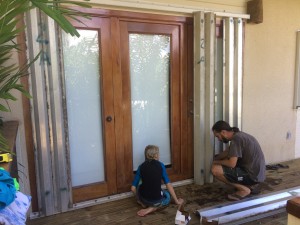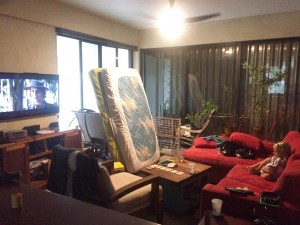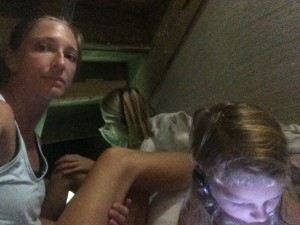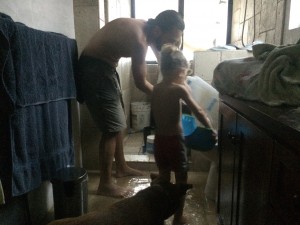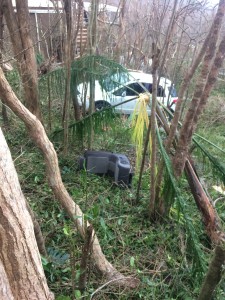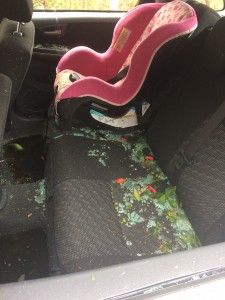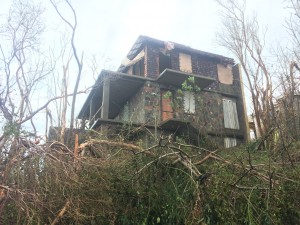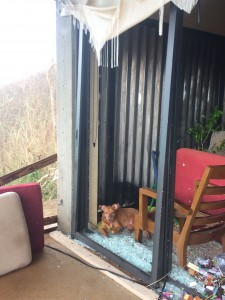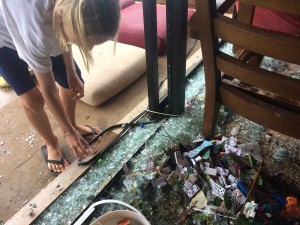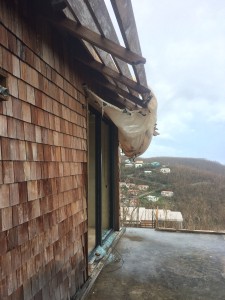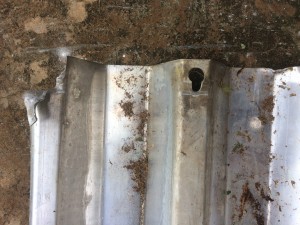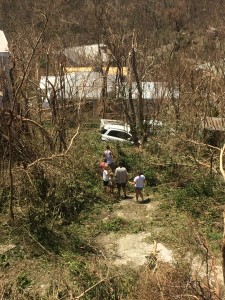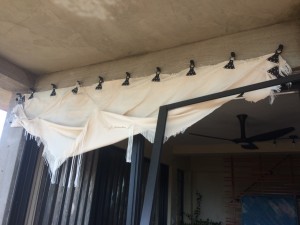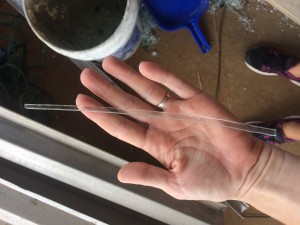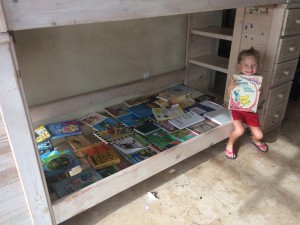September 6, 2018.
Thank goodness for writing. It’s been my therapy over this past year, helped me process my feelings about what we endured, and, when I was ready, allowed me to record the events of September 6, 2017, though I still find myself at a loss when trying to describe what Irma felt like. Regardless, I have tried. If you were here for the storm and you’re trying not to return to that headspace today, maybe skip this post. The photos and videos are from the days leading up to Irma, the day itself, and the aftermath. Posting them here feels like sharing something very personal with the world, but somehow, telling and illustrating our story feels like the right thing to do at this point in time.
—
Her wind speeds registered at 220 sustained and gusts of 274 miles per hour before the Westin’s anemometer broke, but Irma was not just wind. That word, “wind.” It’s too kind, too dainty to describe this storm. She was force. She was pressure. A veritable tornado that sat on top of—and then came in—our house, unrelenting for hours. Her sound was the deepest, loudest rumble of thunder you can imagine, punctuated by gusts that sounded and felt like a freight train booming through the house in tandem with a major earthquake.
We “woke up” the morning of September 6 to the winds picking up (“woke up” in quotes because there wasn’t much sleep to be had knowing what was barreling our way). We huddled together on the living room sofa and tried to watch a movie, but focusing on the story line was impossible as, out of the corner of my eye, I saw the sliding glass doors starting to bow in. The kids and I called it quits early, retreating to our “safe room”—a small space under the stairs with no windows, and again I put “safe room” in quotes for a reason. Our nine-year-old son, Dax, and four-year-old daughter, Norah, played on their tablets, headphones covering their ears in a feeble attempt to block out the growing crescendo of disturbing noises, while my husband, Ted, didn’t stop moving throughout the house, undertaking final last-minute preparations. He tried to jam shut the sliding glass doors that were opening, despite being closed, locked, and protected behind hurricane shutters. He watched as hurricane shutters were stripped off our neighbor’s house by the growing winds, and trees—not branches but large, mature, fully grown trees—soar through the cut between our house and our neighbor’s. I registered his pacing as primal and instinctual, and in those moments, I knew that our family was in the best hands. When the sliding glass doors bowed in six inches during increasingly powerful gusts, Ted finally retreated with us to our little space under the stairs.
We tracked Irma’s progress on the weather radar until cell service flickered, dwindled, and disappeared altogether. The eye was approaching the island’s east end, and we waited anxiously for the calm, the respite that the eye would bring before all hell broke loose again. “Hanging in there. We’re almost to the eye. Ready for a break before the insanity starts again,” I messaged my family—the last they would hear from me for five days.
And then, one by one, our large sliding glass doors, upstairs and down, started to explode. When the first door went, less than 10 feet from where we sheltered, the pressure change inside the house was immediate and profound. Our shirts vibrated on our bodies. Rain came down on our heads through the staircase above, water inching up our ankles as our nine-year-old leaned into the idea that this was the end, and he bid his family a tearful farewell.
Horrifying, unexplainable noises sporadically broke through the deep rumble of the winds; their sources were identified later that night, when it was safe to move about the house and survey the damage. An entire assembly of galvanized aluminum shutters ripped off the house, the quarter-inch tapcons leaving gouge marks on the concrete balcony before the shutters flew through the air and twisted grotesquely around one of the few nearby trees that remained upright. The wing nuts that held some of our fabric shutters in place snapped, leaving the large swaths of reinforced fabric to flail in the wind, their fasteners banging ferociously against the house. Some of the kids’ books rolled, waterlogged, down the stairs above our heads, making the oddest soft thumping noises. Dax’s box spring was sucked from his top bunk and into the upstairs hallway where it turned a corner and flew into our room, before our bedroom door slammed shut with such ferocity that it wouldn’t close properly for months afterwards. Trees and other debris smashed into the house, furniture was sucked out through gaping openings where the sliding glass doors used to be, and perhaps most incredibly, a three and a half inch thick solid mahogany door that led from the kids’ room to a small balcony simply splintered apart, sucked from its jamb in pieces and out into the yard.
Finally, the storm started to abate ever so slightly, and I breathed in deeply, noting that I’d barely been breathing at all. The eye was finally here. And then the storm roared to life again, rendering me confused for a moment before I realized what happened. The storm had shifted north slightly, so instead of enduring the western eye wall then a break followed by the eastern eye wall, we got the tiniest slice of inner eye wall, the calm of the storm’s eye so close within reach, before being battered by the southern eye wall. There would be no break; the torment would continue.
The walls of our hiding spot under the stairs flexed and showered us with plaster dust. I braced my arm against the wall pulsating behind me, preparing for debris to smash through, fully understanding that my spindly stick of an arm afforded no real protection but knowing that I couldn’t just sit there and let the worst happen. I mouthed to my husband, “Are we safe?” hoping our children, who could no longer be distracted by their tablets and headphones, wouldn’t register my doubt. He gave me a half smile and a barely perceptible shrug, but didn’t answer. The water started pouring in from above even faster, and in that moment, we faced the question that most others on island had to consider that day: “Are we still safe here? If not, how do we get somewhere that we are?”
We decided to make a quick jump into the bathroom next to us. We were barricaded under the stairs by large rolling pantries that nest perfectly beneath the stairwell, stocked heavy with food. We grabbed whatever supplies we could hold and Ted braced himself to push one of the rolling pantries against the wind, allowing us to exit, but as he began wheeling the pantry out, he realized quickly that he needed to change tactics. Irma’s pressure was sucking the pantry out from under the stairs, forcing him to pull back on the large wooden structure to keep it from smashing into the adjacent wall.
With the exit open, the kids and I ducked left, our feet swishing through the inches-high water, and into the bathroom. I refused to look right to the living room, where the storm swirled inside, but Ted did and was met with complete white-out conditions. He couldn’t see the ceiling fan five feet in front of him as he dove after our dog, a very anxious old girl who we’d drugged in anticipation of the storm, as she wandered toward the living room in search of her bed, completely oblivious that all hell had broken loose inside the house. Once we were all in the bathroom, dog included, we closed the door and took a moment to try and catch our breath, but it became immediately apparent that pausing was a luxury we wouldn’t be afforded in that moment. The bathroom door refused to stay shut so Ted sat on a stool with his back pressed to the door, straining against Irma’s attempts to force her way in. The door BANGED and BANGED and BANGED as I watched in disbelief and then a tiny, tearful voice came from the shower on the opposite side of the bathroom: “Mommy, I’m scared!” Norah, our baby girl, so terrified and alone in the shower, where she’d jumped to avoid the water on the floor. Before I could give in to mother’s instinct and scoop her up to comfort her, Ted was showing her how to use a small plastic trash can to scoop water from the floor and pour it down the toilet, where it was immediately sucked away by the storm’s pressure. And that is how we passed the next hour or so, taking turns scooping up the water, our minds focused on one unified task rather than on the fury that raged all around us.
Early that evening, when the door finally stopped banging, we hesitantly stepped out of the bathroom. Ted took on the task of going upstairs to survey the damage; I knew I wasn’t ready to see what happened, and I thought for sure our roof was gone. We are so fortunate that the roof stayed in place. The upstairs of our home was a mess of water, shredded plant life, and so much broken glass. The winds seemed calm in comparison to what we’d just gone through, but it took two of us to wrangle open the front door so Ted could take the dog out for a much-needed pee, and it took all of their strength to stay upright on this very fast foray outside, the rain needling their skin. I have never been more mentally exhausted in my life and I could have easily collapsed on the wet, glass-strewn floor and slept right there, but we had the kids to consider. We spent an hour, maybe more, shoveling up as much glass and mopping up as much water as we could in an effort to create a somewhat safe, comfortable-ish place to crash for the night. Upstairs, where our bedrooms are, was in the worst condition so we slept downstairs that night, Ted, Norah, and I crammed together on our pull-out sofa, Dax on a yoga mat spread out across a table top to keep him elevated above the water on the floor—a space he dubbed his “jail bed.” All of our sheets were wet, and with our large sliders broken the house was completely open to the elements, but in a pure state of emotional exhaustion, I was asleep by 8 that night.
I could never look back on that day without thinking of my children. Their room was the hardest hit. All those little bits that hold such importance when you’re a child were sucked out through their shattered, splintered doors, scattered about our property and beyond, some of which we found in the days after the storm, our heartache sinking to a new low with each discovery of ruined memorabilia. Their best artwork they’d elected to display in their room. Pictures and notes from friends. Trinkets collected during our travels as a family. Trophies and certificates. And books, with their familiar dog-eared pages, the kids’ names scrawled on the inside covers in all caps, the way kids do when they’re first learning how to write their letters. Gone. Destroyed. Many tears were shed, but in the end, we were alive, and we had each other. Because when you find yourself in a situation where you’re sure that you’ll die, the worth of your life and the ones you share it with becomes beautifully, painfully apparent.
When I look back on the days, weeks, and months after the storm, I can say without reservation that I am in awe of the way we persevered. The versions of us that endured in those early days feel like separate entities, different from who we’ve always been and who we are today. I look back at those people with sheer amazement. I can’t believe the choices we had to make and how practical and matter-of-fact they seemed at the time. The first three nights after the storm, we ate soggy boxed mac and cheese for dinner, the noodles pre-softened by the water that had blasted through the house during Irma. Dax learned to water down evaporated milk to a perfect milk-like consistency, and this is what we used with our coffee and over cereal. I’d be quite happy to never taste evaporated milk again. During our first post-storm trip to the grocery store, I happily paid a ridiculous amount of money for moldy butter, not knowing when the next grocery shipment might arrive.
In the months after the storm, we often wondered when we would go a full 24 hours without mentioning Irma. The experience dominated so many conversations on a daily basis. For us, it would happen six months later, and it took physically leaving the island on a much-needed spring break vacation to remove ourselves, if only for a while, from what had happened.
As much as September 6 and its aftermath was a living nightmare, the one part of our Irma story that I still can’t share without tears happened in the days leading up to the storm. Dax, who was nine at the time, is so incredibly smart. He is always asking questions, seeking knowledge, and has long been into science, and weather and natural disasters in particular, reading as many books on those subjects as he could get his hands on. As Irma grew in intensity and lined up to make a direct hit on St. John, it was often Dax who would give us the updated forecast while Ted and I worked to secure our home for what was to come. With each category upgrade, I knew Dax was getting nervous, and I just kept telling him: “It will be one very bad day. But we will be safe, and we will be together.” The day Irma was upgraded to a category 5, her projected path barreling straight over our tiny island, Dax was the one to check the forecast. He came to us, tablet in hand with the browser opened to an image of Irma’s latest update. “It’s a category 5,” he said, and something in his voice made me pause and look up at his face. I have never seen such terror in his eyes; his already pale face was drained of the little color he usually has. We try to protect our children from the bad things in life, but in that moment he knew, with far too much clarity, what we were about to go through. And I couldn’t just explain it away.
Now, one year later, we are still met with constant, tiny reminders of the great and powerful Irma, mostly in the form of the tiny pebbles of glass that are still tucked away inconspicuously—embedded in the undersides of furniture in places too hard to reach, or jammed deep in my car’s seats, beyond the grip of the vacuum cleaner. It’s hard to believe it’s been a full year since the storm roared across this tiny island, because Irma is still a constant presence in our lives in so many ways. I’ve accepted that the fear, devastation, and loss we experienced as a result of the storm will forever be a part of our story. But so too will our strength and resilience, the kindness that was showed to us by others, the way this island community came together, and the realization that we can overcome.
Below is a collection of photos I took from before the storm through several days after. Click on the first photo and click through the images for descriptions of each.
- My son and husband shutter up the condo. Our condo’s building would lose its roof in the storm, and finally, two days after the one-year anniversary, we welcomed our first post-storm guests.
- My son’s attempt at optimism. The railing his sign is hanging from blew away in the storm.
- Fabric shutters over one of our large sliding glass doors. This shutter was partially torn from the wall and this was the first of our doors to break during the storm.
- 9 a.m. on September 6. The kids and I watched movies in the living room until the sliders started bowing.
- 10 a.m. We gave up on movies in the living room and went to our designated “safe spot” under the stairs.
- 10:47 a.m. The last screenshot I took of the weather radar before we lost cell service. I’ve added a circle around St. John. We were certain the eye was coming our way and were looking forward to the break.
- My husband and daughter scoop water from the floor and pour it down the toilet, where the storm’s pressure sucked it away.
- 5:33 p.m. Our bedroom. Our clothing racks were toppled and some clothes were sucked out into the yard. The sheets and mattress topper were ripped off our bed.
- 6:06 p.m. The living room. Everything was soaked and there was glass, plant debris, and pieces of the kids’ books everywhere.
- The following photos are from September 7 onward. This is our room. The large white object is our son’s box spring, which was sucked out of his room, twisted around in the narrow upstairs hallway, then sucked into our room before our bedroom door slammed shut. The walls look mottled because everything was soaking wet.
- This black chair was sucked out of the kids’ room and thrown into the yard.
- My car lost two windows during the storm.
- Our house from the driveway. It was battered for sure, but overall the house stood strong.
- The hot tub, sucked out of its housing and tossed into the yard.
- We never see iguanas up at our property, yet there this guy was the morning after. I’m sure he was stunned and I can only imagine how he got here.
- The dog laying in the pebbled glass remains of one of our sliding glass doors.
- Our son picking some of his toys from the glass debris.
- The fabric shutters that failed in the kids’ room.
- One of the aluminum shutters that failed. You can see where it ripped and folded back at the top of the photo.
- One of the countless helicopters that we saw land at the nearby clinic’s helipad. There would be times when one helicopter was on the helipad and three others were circling, waiting to land.
- Dear friends of ours walking down the driveway with my husband and our kids. They were one of the few to brave the trip up to our house to check on us. It took us five days before we could clear the driveway so I could get to town and get word out to our families that we were okay.
- The shredded remains of one of our fabric shutters.
- This is one of the tracks that held the aluminum shutters in place on our room’s sliding glass doors. My husband recovered it from the yard, twisted and bent.
- We found all kinds of interesting broken glass in the days after the storm. Our daughter kept a collection of the pieces she found prettiest.
- The kids’ room. Leaves, debris, glass, and shredded book pages were everywhere.
- My little thinker. I caught him staring off like this many times in the days after the storm. There was certainly a lot to process.
- The pile where we threw the remains of the kids’ room. This pile remained in the yard until we went on vacation six months later and our sweetest house sitter took it upon herself to remove it, surely realizing how difficult it would have been for me to revisit its contents.
- Some of the kids’ books that we tried to salvage. Sadly, mold took most of them.
- Four days after Irma hit. St. John is still so beautiful.
- Our daughter helping with the clean up. The day we could go barefoot in the house again was a big milestone!
- Our son stringing up the flag that used to hang in their room and was found in our neighbor’s yard after the storm. Nothing can take away our love for this place!

